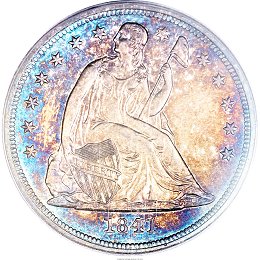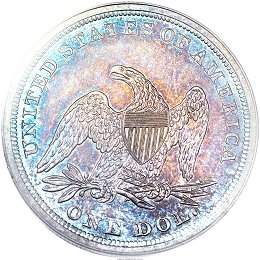 |
1841 
 |
 |
General Comments
|
| |||||||||||||||||||||
High-grade business strikes are sometimes prooflike, but more often frosty. With high mintage, only four business strike die pairings, and only two business strike obverse dies, the dies wore sufficiently to eliminate prooflike surfaces for most examples. Nice prooflike examples can be located with patient searching.
1841 Die Marriages
6 die marriages have been positively identified. Two obverse dies were paired with 3 reverse dies, one transitional from 1840, to strike five business strike die pairs. One of these was a re-marriage of Obverse 1 and Reverse 1840 A. None of the business strike dies were used for proofs. A second re-marriage of die pair 1-1840 A exists, since both OC-1 and OC-2 are found with reverse die state d, but with no differences in intermediate states other than die polishing itís impossible to say for sure exactly where in the sequence it occurred.
Iíve identified only a single proof die marriage (see the previous section for a possible exception). It combines a unique obverse die with the reverse die used for almost all original proofs through 1854.
The table below summarizes the known die marriages for 1841. Breen lists a ďsmall starsĒ proof, Breen 5427. I havenít noted any significant difference in the size of the stars. However, since Iíve identified only one proof die marriage, itís not really an issue.
Click the links below to view the details of each die marriage.
Die Marriage |
Rarity |
Obverse Die |
Reverse Die |
Estimated Survivors |
| OC-1 | R3+ | 1 | 1840 A | 275 |
| OC-1a | R3+ | 1 | 1840 A | 285 |
| OC-2 | R1 | 1 | A | 1800 |
| OC-3 | R1 | 2 | 1840 A | 1250 |
| OC-4 | R1 | 2 | B | 1640 |
| OC-P1 | R7- | P1 | 1840 PA | 10 |
1841 Business Strike Emission Sequence
The obverse die sequences were easily determined due to die polishing and rim cuds on
later states of obverse 1 and rim cuds on the late state of obverse 2.
Emission Order |
Die Marriage/ |
Comments |
| 1 | OC-1 1 - 1840 A | The earliest state of Obverse 1 exhibits repunching on the 4. |
| 2 | OC-2 1 - A | Early state examples retain the repunching on the 4. In later states the die was polished, removing evidence of the repunching, indicating that OC-2 was issued after OC-1. |
| 1 | OC-1a 1 - 1840 A | In its latest state die marriage 1-1840A exhibits state d of Obverse 1, with minor rim cuds. This indicates that some examples of the marriage were struck after die marriage 1-A. |
| 3 | OC-3 2 - 1840 A | A greater extent of die polishing on Reverse 1840 A indicates that OC-3 was issued after OC-1a. |
| 4 | OC-4 2 - B | Rim cuds below date in the latest die state indicate that OC-4 was issued after OC-3. |
1841 Proof Emission Sequence
With only a single proof die marriage identified the emission sequence is simple.
Emission Order |
Die Marriage/ |
Comments |
| 1 | OC-P1 P1 - 1840 PA | No other proof die marriages have been identified. |
1841 Quick Finder Chart
Notably different date placement makes the 3 obverse dies easy to identify. The reverse differences are
subtle, but attribution should be easy for any examples grading F12 or better. The steps that lead to
quick attribution are as follows: First use the date placement to identify the obverse die. Each obverse
is paired with just two reverses (only one for the proof). Next review the die markers that characterize
the reverses paired with your obverse. Finally use these markers to identify the reverse, and thus the
die marriage. If the determination is OC-1 use the obverse die state to determine whether itís OC-1 or
OC-1a. None of the business strike die marriages are particularly rare, so only those collectors wishing
to assemble a die marriage set need to worry about attribution.
Die Marriage |
Obv. Die |
Rev. Die |
Right Base |
Keys to Identification |
| OC-1 | 1 | 1840 A | L QTR | Obverse - Right date, 5-4.0. Repunched 4. Light die lines extend down to the right from the lower right edge of the shield. Reverse - Vertical shield line 3-3 extends through the inside shield border. |
| OC-1a | 1 | 1840 A | L QTR | Obverse - Right date, 5-4.0. Repunched 4. Light die lines extend down to the right from the lower right edge of the shield.
Obverse die state b or later Reverse - Vertical shield line 3-3 extends through the inside shield border. |
| OC-2 | 1 | A | L QTR | Obverse - Right date, 5-4.0. Light die lines from shield still visible. Repunched 4 gone. Reverse - Vertical shield line 1-2 extends into the horizontal lines to line 5. |
| OC-3 | 2 | 1840 A | B | Obverse - Left date, 4-4.5. Die lines slant down to the right above the leg, left of the pole base. Reverse - Vertical shield line 3-3 extends through the inside shield border. |
| OC-4 | 2 | B | B | Obverse - Left date, 4-4.5. Die lines slant down to the right above the leg, left of the pole. Reverse - A faint die line visible in shield recesses 3 and 4, extending across the vertical shield lines, just above the middle of the recesses. |
| OC-P1 | P1 | 1840 PA | C | Obverse - A tiny but strong die dot in the gown just above and left of the pole.
Reverse - Defects on A3. |
